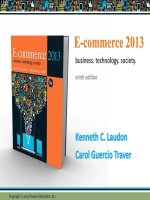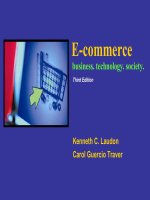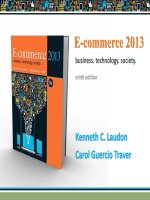Lecture E-commerce: Business, technology, society (3/e): Chapter 7 - Kenneth C. Laudon, Carol Guercio Traver
Bạn đang xem bản rút gọn của tài liệu. Xem và tải ngay bản đầy đủ của tài liệu tại đây (1.99 MB, 60 trang )
E-commerce
business. technology. society.
Third Edition
Kenneth C. Laudon
Carol Guercio Traver
Copyright © 2007 Pearson Education, Inc.
Slide 7-1
Chapter 7
E-commerce Marketing Concepts
Copyright © 2007 Pearson Education, Inc.
Slide 7-2
NetFlix Develops and Defends Its Brand
Class Discussion
What was NetFlix’s first business model?
Why did this model not work and what new
model did it develop?
Why is NetFlix attractive to customers?
How does NetFlix distribute its videos?
What is NetFlix’s “recommender system?”
How does NetFlix use data mining?
Is video on demand a threat to NetFlix?
Copyright © 2007 Pearson Education, Inc.
Slide 7-3
Consumers Online: The Internet
Audience and Consumer Behavior
Around 175 million Americans (67% of total
population) had Internet access in 2005
Growth rate has slowed
Intensity and scope of use both increasing
Copyright © 2007 Pearson Education, Inc.
Slide 7-4
Internet Audience and Consumer
Behavior
Some demographic groups have much higher
percentages of online usage than other groups
Demographics to examine include:
Gender
Age
Ethnicity
Community Type
Income
Education
Copyright © 2007 Pearson Education, Inc.
Slide 7-5
Type of Internet Connection: Broadband
Impacts
52 million Americans had broadband access
by end of 2005
Broadband audience quite different from dialup audience:
Wealthier
More educated
More middle-aged
Greater intensity and scope of use
Copyright © 2007 Pearson Education, Inc.
Slide 7-6
Lifestyle Impacts
Intense Internet usage may cause a decline
in traditional social activities
Social development of children using Internet
intensively instead of engaging in face-to-face
interactions or undirected play may also be
negatively impacted
The more time people spend on the Internet,
the less time spent using traditional media
Copyright © 2007 Pearson Education, Inc.
Slide 7-7
Consumer Behavior Models
Attempt to predict/explain what consumers
purchase and where, when, how much and
why they buy.
Consumer behavior models based on
background demographic factors and other
intervening, more immediate variables
Copyright © 2007 Pearson Education, Inc.
Slide 7-8
A General Model of Consumer Behavior
Figure 7.1, Page 367
SOURCE: Adapted from Kotler and Armstrong, 2006.
Copyright © 2007 Pearson Education, Inc.
Slide 7-9
Background Demographic Factors
Cultural
Culture and subculture
Social
Reference groups
Direct
Indirect
Opinion leaders (viral influencers)
Lifestyle groups
Psychological
Psychological profiles
Copyright © 2007 Pearson Education, Inc.
Slide 7-10
Factors That Predict Online Buying Behavior
Figure 7.2, Page 371
SOURCE: Lohse Bellman, and Johnson, 2000.
Copyright © 2007 Pearson Education, Inc.
Slide 7-11
The Purchasing Decision
Five stages in the consumer decision
process:
Awareness of need
Search for more information
Evaluation of alternatives
Actual purchase decision
Post-purchase contact with firm
Copyright © 2007 Pearson Education, Inc.
Slide 7-12
The Consumer Decision Process and
Supporting Communications
Figure 7.3, Page 371
Copyright © 2007 Pearson Education, Inc.
Slide 7-13
A Model of Online Consumer Behavior
Adds two new factors:
Web site capabilities
Consumer clickstream behavior
Copyright © 2007 Pearson Education, Inc.
Slide 7-14
A Model of Online Consumer Behavior
Figure 7.4, Page 372
Copyright © 2007 Pearson Education, Inc.
Slide 7-15
Shoppers: Browsers and Buyers
About 63% of online users purchase online;
an additional 12% research online, but
purchase offline
Significance of online browsing for offline
purchasing and vice versa should not be
underestimated
E-commerce and traditional commerce are
coupled and should be viewed by merchants
and researchers as part of a continuum of
consuming behavior
Copyright © 2007 Pearson Education, Inc.
Slide 7-16
Online Shoppers and Buyers
Figure 7.5, Page 375
SOURCE: Based on data from eMarketer, Inc., 2005a; Shop.org, 2005; authors’ estimates.
Copyright © 2007 Pearson Education, Inc.
Slide 7-17
What Consumers Shop for and Buy
Online
Online sales divided roughly into small ticket and big
ticket items
Top small ticket categories (apparel, books, office
supplies, software, etc.) have similar
characteristics—sold by first movers, small
purchase price, physically small, high margin
items, broad selection of products available
Purchases of big ticket items (travel, computer
hardware, consumer electronics) expanding
Copyright © 2007 Pearson Education, Inc.
Slide 7-18
What Consumers Buy Online—Small
Ticket Items
Figure 7.6, Page 376
SOURCE: Based on data from eMarketer, Inc., 2004b.
Copyright © 2007 Pearson Education, Inc.
Slide 7-19
What Consumers Buy Online—Large
Ticket Items
Figure 7.6, Page 376
SOURCE: Based on data from eMarketer, Inc., 2004b.
Copyright © 2007 Pearson Education, Inc.
Slide 7-20
Intentional Acts: How Shoppers Find
Vendors Online
Over 85% of shoppers find vendor sites by
typing product or store/brand name into
search engine or going directly to the site
Most online shoppers plan to purchase
product within a week, either online or at a
store
Most online shoppers have a specific item in
mind
Copyright © 2007 Pearson Education, Inc.
Slide 7-21
Why More People Don’t Shop Online
Major online buying concerns:
Security
Privacy
Shipping costs
Return policy
Product availability
Shipping issues/delays
Copyright © 2007 Pearson Education, Inc.
Slide 7-22
Trust, Utility, and Opportunism in Online
Markets
Trust and utility among the most important factors
shaping decision to purchase online
Consumers are looking for utility (better prices,
convenience)
Asymmetry of information can lead to opportunistic
behavior by sellers
Consumers also need to trust merchants before
willing to purchase
Sellers can develop trust by building strong
reputations for honesty, fairness, delivery
Copyright © 2007 Pearson Education, Inc.
Slide 7-23
Basic Marketing Concepts
Marketing: The strategies and actions firms
take to establish a relationship with a
consumer and encourage purchases of
products and services
Internet marketing: Using the Web, as well as
traditional channels, to develop a positive,
long-term relationship with customers,
thereby creating competitive advantage for
the firm by allowing it to charge a higher price
for products or services than its competitors
can charge
Copyright © 2007 Pearson Education, Inc.
Slide 7-24
Basic Marketing Concepts (cont’d)
Firms within an industry compete with one another on
four dimensions:
Differentiation
Cost
Focus
Scope
Marketing seeks to create unique, highly
differentiated products or services that are produced
or supplied by one trusted firm (“little monopolies”)
Copyright © 2007 Pearson Education, Inc.
Slide 7-25









